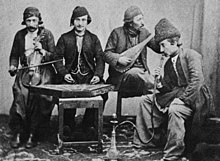You can help expand this article with text translated from the corresponding article in Russian. (March 2024) Click for important translation instructions.
|

The Ruska Roma (Руска Рома), also known as Russian Gypsies (Русские цыгане) or Khaladitka/Xaladytka Roma (Халадытка Рома; lit. 'Roma Soldiers'), are the largest subgroup of Romani people in Russia and Belarus, with smaller remnants of the group living in Ukraine, Latvia, Poland, the United States, France, and Canada. They formed in the Northwestern part of the Russian Empire from the Polska Roma who immigrated to the country in the 18th century.
Ruska Roma are divided into territorial subgroups, whose names come from the locality. For example, Pskovska Roma (from Pskov), Smolyaki (from Smolensk), Siberyaki (Siberian), Zabaykaltsi (Transbaikalian) and Bobri (beavers). Furthermore, Ruska Roma are related to Belaruska Roma: they have a common origin and were traditionally called Chaładytka Roma.
The Ruska Romani language contains Russian, Polish, and German lexicon, as well as some Russian and Ukrainian grammar. Most Ruska Roma are Orthodox Christians.
Role in Russian history


Judging by the language of Russian Roma, their ancestors spent time in Germany and Poland before coming to the East Slavic territories. Sources start mentioning Roma on the territory of Russia from the beginning of the 18th century. For instance, Scottish traveler John Bell wrote about Roma arrivals from Poland, sent away from the Tobolsk region in 1721.
Arrivals became involved in entertainment, playing and singing at large celebrations. During the 19th century, Russian Roma living in Moscow and Saint Petersburg created Romani choirs, which became popular among the Russian urban population. Nomadic Russian Roma engaged in horse dealing and fortune telling.
A drastic change in the life of nomadic Russian Roma took place in 1956 when a Soviet government decree banned Roma from their nomadic lifestyle. They were forced to settle in houses. Nowadays Russian Roma often live dispersed, but they tend to settle amongst other Roma to form a sense of belonging. Russian Roma prefer to live in private houses, but it is not uncommon for a Russian Romani family to live in a flat.
Notables
- Nikolai Slichenko, Russian singer
- Nikolai Shishkin, Russian theatre personality
- Valentina Ponomaryova, singer, theatre actor
- Timofey Prokofiev, marine infantryman, Hero of the Soviet Union
In popular culture
Film
In the John Wick film franchise, the titular character John Wick (born Jardani Jovonovich) is a former member of the Ruska Roma. In the series, the Ruska Roma are depicted as an organized crime syndicate and member of the "High Table", a collection of underworld crime organizations.
See also
References
-
"Roma and 'Gypsies'". Retrieved 11 February 2016.
Ruska Roma Also called 'Xaladitka Roma' (Gypsy soldiers), are the most numerous group in Russia. These are probably the first Roma who settled in that land, likely coming from the Caucasus, and they speak an Old Romany language. They are widespread throughout Russia even up to the Kamchatka Peninsula and across the boundaries with China, as well as in Ukraine, and some of them live beyond the western border, in Poland. The Ruska Roma are an endogamic group which keeps the Romany Law.
- ^ "Nomadic people. N.Bessonov. National Geographic Russia, April 2007". Archived from the original on 28 April 2007.
- "Russian Roma". coe.int. Retrieved 26 March 2024.
- ^ "Factsheets on Roma". romafacts.uni-graz.at.
External links
- Russian Roma. Factsheets on Romani culture
- The Kolpakov Trio Brings The Roma Renaissance
- Roma - Minority Rights Group
| Romani people in Europe | |
|---|---|
| Sovereign states |
|
| States with limited recognition | |
| Dependencies and other entities | |
| Ethnic groups in Russia | |||||||||||||
|---|---|---|---|---|---|---|---|---|---|---|---|---|---|
| Titular nationalities | |||||||||||||
| Indigenous peoples |
| ||||||||||||
| Other ethnic peoples |
| ||||||||||||
| Unrecognized peoples | |||||||||||||
| Assimilated peoples | |||||||||||||